The name Normandy has a special significance for those of us who grew up in the United States. It is a place that brings up mental images of Saving Private Ryan, Band of Brothers… and if you are old enough… The Longest Day. But Normandy was making history long before WWII and I have been wanting to visit as long as I can remember.
A canal cruise in southern France brought my wife and me to France so we decided to add on 3 extra days in Normandy. What can you see in only 3 days in an area rich with history? Quite a lot as it turns out. Here is my suggested itinerary.
Table of contents: ()
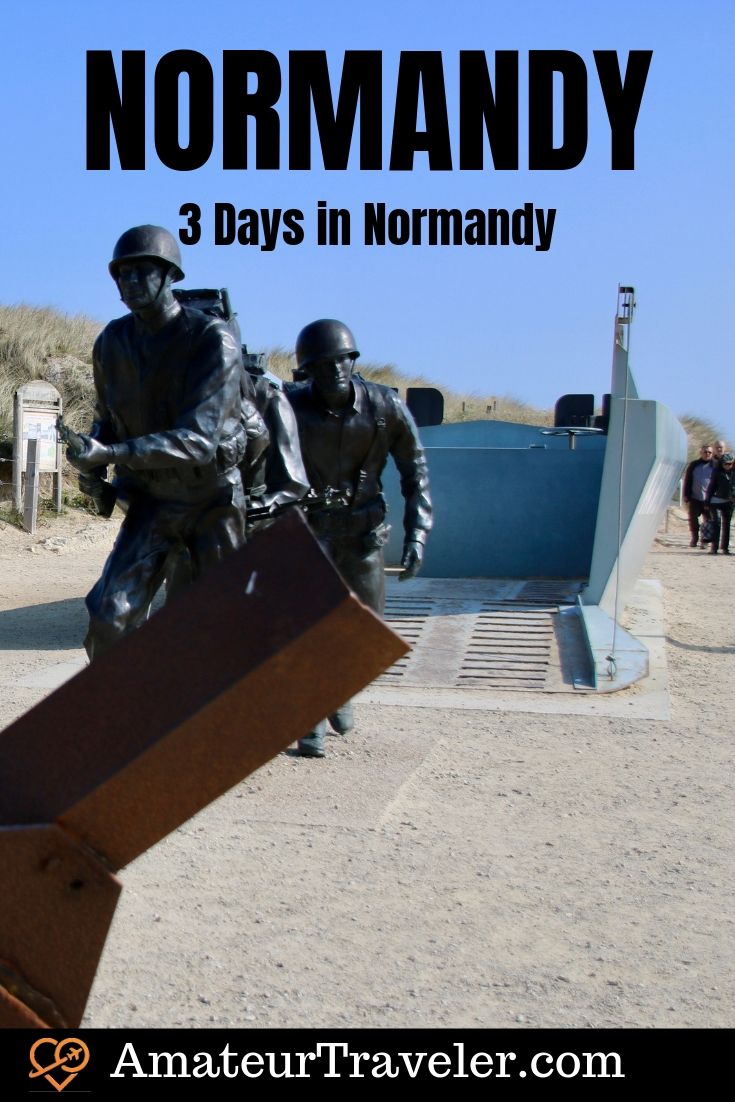
Paris to Normandy
We arrived in France in the afternoon and immediately rented a car and headed to the town of Bayeux in Normandy. We could have taken the train or flown to Normandy but unless you are taking a tour, you will want a car to get around. Driving is on the right and most French drivers are pretty good… at least up to 110 Kilometers per hour.
I don’t suggest you get on a 10 hour overnight flight and then drive for 3 hours until you have learned how to sleep on a plane, although that is what we did. The tolls on the route from Charles de Gaulle airport to Bayeux were 24.80 euros.
If you want to play it safe there are some airport hotels that are ridiculously easy to get to from the Charles de Gaulle airport. Take the train from the Terminal where you land to Terminal 3 where you can catch a train to the city but instead of taking the train, reserve one of these hotels which are just outside the doors of Terminal 3. We stayed in the ibis Paris CDG Airport which is basic but modern.
- ibis Paris CDG Airport
- citizenM Paris Charles de Gaulle Airport
- Novotel Paris Charles de Gaulle Airport
- Pullman Paris Roissy Cdg Airport
- Hilton Paris Charles De Gaulle Airport
- ibis Styles Paris Charles de Gaulle Airport
Get some sleep and then return in the morning to pick up a rental car.
Bayeux
We chose a home base of the historic town of Bayeux (pronounced something like “ba yuh”). We stayed in the lovely Hotel Le Lion D’Or which is right in the historic center of town.
Bayeux was the jumping-off point for the invasion of England by William the Conqueror and Bayeux was also the first French city to be liberated in Normandy in 1944.
Day 1
We dedicated the first full day of our visit to the WWII history surrounding the Normandy landings.
Normandy Beaches
It is 4 miles south from the Normandy coast and about in the middle between the U.S. invasion beaches and the British and Canadian beaches during D-Day June 6, 1944.
The beaches sit on a section of France’s coast that faces north towards England.
The U.S. beaches of Utah and Omaha are to the north and west from Bayeux and the British and Canadian beaches of Gold, Juno, and Sword to the north and east from Bayeux.
With only one day for the beaches, I would explore one half or the other depending on which you are more affiliated with. We opted for the western U.S. invasion zone. We spent Thursday visiting some of this 50 mile stretch of beaches.
Sainte-Mère-Église
Sainte-Mère-Église was at the far western end of the allied landings on D-day just past Utah beach. The landings at Utah were a gamble because the land behind the beach had been flooded by the Germans and the beach was only accessible by a few narrow causeways. American paratroopers were dropped into the area in the early morning hours or landed by glider. Their mission was to secure the vital causeways off Utah beach. They succeeded although with significant losses. But their failure would have doomed many who landed at Utah beach.
Sainte-Mère-Église has the distinction of being the first French town liberated by Allied groups.
We started with the Airborne Museum in Sainte-Mère-Église. This was a fascinating high tech museum that handed you an interactive tablet when you entered that you could use to see the field you were on covered with gliders in the early hours of June 6th or you could watch yourself jump out of a plane and possibly end up stuck on the church steeple like one unfortunate parachutist.
When you look up at the steeple of the church in Sainte-Mère-Église you can still see a mannequin dressed as a parachutist that hangs there. This is a reminder of John Steele of the 82nd Airborne who did, in fact, end up trapped hanging from the church belfry for two hours feigning death until he was retrieved and captured by German soldiers. He was part of two sticks (planeloads) of soldiers dropped in error directly on the town. Many of those soldiers were wounded or killed. He managed to escape captivity after 5 days so he was fortunate.

For some unique stain glass windows go inside the church. One window has Madonna and child surrounded by paratroopers. Another has Saint Michael, the patron saint of paratroopers, with sword drawn which bears saying “Ils Sont Revenus” “They Have Come Back”). The first was designed by a local artist in 1945 and the second was commissioned by veterans of the 82nd Airborne on the 25th anniversary of their jump.
Utah Beach
After Sainte-Mère-Église we drove to Utah Beach which has a terrific museum built around one of the original German bunkers. That bunker is now the restaurant Le Roosevelt which makes a great spot to stop for lunch. The restaurant is named after the highest-ranking general to participate in the first wave of the invasion, Theodore Roosevelt Jr. the son of the president. He survived the landings, but the 57-year-old Roosevelt died of a heart attack in France a month later.
A popular photo spot is in front of the Higgens boat statue outside where 3 U.S. G.I.s are perpetually hitting the beach. The museum houses many notable exhibits including an original B26-Martin Marauder bomber and a Higgens boat (landing craft, vehicle, personnel – LCVP).
Take a moment to walk through the dunes for a view of what is now a peaceful beach. Development is very restricted on the landing beaches.
Pointe du Hoc Ranger Monument
Midway between the Utah and Omaha beaches was a German gun emplacement on a promontory sitting on cliffs where the Germans could steel both landing beaches. On the early morning of June 6th, a specially trained group of U.S. Rangers approached the cliffs from the water and fired large grappling hooks so that they could scale the cliffs and disable the guns. The boats first ended up on the wrong part of the shore, then the grappling hooks did not work as planned.
Much went wrong with the operation including the surprise that when they finally reached the top after great loss of life the guns had been moved. They were however quickly located and disabled. The Pointe du Hoc Ranger Monument includes the remains of the original German positions and the shell craters from the initial naval bombardment of the site.
Omaha Beach
Omaha Beach was the bloodiest of the 5 landing beaches. This is the beach we watched Tom Hanks and his squad assault in Saving Private Ryan. These days a large metal sculpture dominates the beach. The sculpture, Les Braves Omaha Beach Memorial, is supposed to represent the wings of Hope and Fraternity as well as the call “Rise, Freedom!”.
There are a great number of museums in the Normandy area. The museum at Omaha beach was one of the ones with a good reputation but we mistakenly visited the one right by the beach which frankly I don’t think is worth your time. Skip that and visit the one further back that road called the Overlord Museum. The D-Day landings were the opening battle of the Battle of Normandy which bore the codename Operation Overlord.
The largest of the American cemeteries is near Omaha Beach. It is worth a visit, especially at the end of the afternoon when they will blow taps and lower the American Flag.
Day 2
The second day we venture to the western edge of Normandy where it meets up with Britany. There, just off the mouth of the rivers Sélune, Sée and Couesnon is the medieval monastery and fortress of Mont Saint-Michel.
Mont Saint-Michel
We visited the abbey of Mont Saint-Michel. You have probably seen pictures of this abbey built on a rock in the bay off the coast of Normandy. So had we but we still let out an involuntary “wow” when it came into view. We had been told about how bad the crowds get, but all I can say is visit at the end of March like we did to escape the crowds in Normandy. Our weather has been chilly in the mornings but sunny and warm by mid-day.
We did see that if you are there when the crowds are you can take the main busy tourist street up to the abbey or just inside the gate you can take the back way up. We went up one way and back the other.
Mont Saint-Michel is known for its tides that turn the abbey into an island at high tide, or at least they used to before the causeway was built. We parked our car where everyone must park and then instead of taking the free shuttle we walked out to the abbey to enjoy the views. It does take a while to walk so we grabbed the free shuttle back again.
Mont Saint-Michel is quite touristy when you are on the main drag but I loved it. We did not do all the tiny museums you can at Mont Saint-Michel: Archeoscope, Museum of history, Maritime and ecology museum, and Tiphaine’s house. You can get a combined entry for 9 euros but they seemed to have mixed reviews. The signage, as we understand, is only in French so we opted to skip them on our abbreviated 3-day visit.
We did tour the main abbey with the audio guide tour which I would highly recommend. Admission was 10 euros each plus we got one audio guide for 3 euros. The audio guide described how the different rooms were used over the ages including a time when the island was a prison in the 1700s.
Mont Saint-Michel abbey and the bay are a UNESCO World Heritage site.
Cider and Calvados at Billy’s Farm
Our visit to Mont Saint-Michel did not take all day so we used some of the afternoon to taste the apple cider and calvados that Normandy is known for. The area grows a lot of apples so some smart French person long ago figured out that there must be some way to make them into alcohol. While we were familiar with hard cider we had never tried calvados which is an apple or pear brandy.
We walked around the grounds of the farm including some of the orchards. There is a chapel on the grounds that we later learned is original to the farm from the 1600s. We also walked through the barrel room where the Calvados was aging.
When we got back to the tasting room, a young woman offered us tastings of 3 ciders, 3 vintages of Calvados (44% alcohol) and a 2 different pommeaus (a mixture of Calvados and apple juice, at 17 and 22% alcohol) and an ice apple cider (or wine, we aren’t sure) made by letting the apples freeze. The 3 ciders varied by sweetness level: sweet, fraische, and brut. The Calvados began at aged 8, 12, or 25 years. We liked the middle of both ranges. We were surprised to find that we liked the ice wine, which isn’t light like grape ice wine and is richer, a bit like a port. We got a bottle of that to take with us.
We found a great place to taste cider at Billy’s Farm in Rots, which is 23 minutes east of Bayeux. Billy’s Farm was a quirky laid-back farm with lots of art and character. They also happen to make good apple alcohol.
Bayeux Tapestry
In Bayeux, you can find the historic Bayeux Tapestry which we visited at the end of day 2. The Bayeux Tapestry is a 230 foot long (70 meters) tapestry that tells the story of the invasion of England in 1066 from William’s point of view.
The tapestry depicts William the Conqueror’s victory over Harold the “oath breaker”. Pay special attention to the story before the invasion where Harold swears an oath to William and even fights alongside him. Keep an eye out for Halley’s Comet that makes an unnerving appearance around the death of King Edward the Confessor, Harold’s brother-in-law. Harold’s death without heir precipitated the Norman Invasion.
The tapestry is housed in its own museum which takes about an hour and a half to visit. It is well-presented so that even non-history buffs can appreciate it.
Day 3
On our 3rd day, we needed to make our way back to Charles de Gaulle to catch the TGV the next day down to southern France for our luxury canal barge cruise. We worked our way back through two old historic cities of Normandy.
Honfleur
The harbor at Honfleur connects the strategic Seine River with the English Channel and the Atlantic Ocean. It was a major harbor for the French until the building of the modern harbor at Le Havre. It started to decline during the 18th century which preserved the historic nature of the old city.
Besides the colorful harbor the other site to see in Honfleur is the wooden church of Saint Catherine of Alexandria which is the oldest wooden church in France. The church was constructed as a “temporary church” just after the Hundred Year’s War. The church builders were shipbuilders and you can see how its double nave looks like two upside-down ships. One of the reasons it still stands is that the bell tower was constructed unconnected to the church in case of fire started by lightning strikes… which did happen.
When we arrived there was a large market near the port and by the church, with clothing, baskets, fish, meat, baked goods, and lots of produce.
Rouen
Rouen is the capital of the Normandy region. It was one of the capitals of the Anglo-Norman dynasty founded by William the Conqueror. During that time it was one of the largest and most important cities in France. The city has numerous streets with historic half-timbered buildings.
The city is perhaps best known for the place where Joan of Arc was burned at the stake. Near that spot today is a church dedicated to the now canonized Joan. The church is a very modern church and quite different than the typical French church you have seen. We also saw the city’s main cathedral which is lovely but not exceptional.
- Book Your Accommodation HERE
- Get a universal plug adapter
- Get a Car Rental
- Search for Great Tours HERE
- Buy Travel Insurance
- Get an eSim to be able to use your smartphone abroad.

We visited the Fine Art Museum (Musée des Beaux-Arts de Rouen) which is worth a stop unless you are heading to Paris and will have time to see the art museums of that city. It is free. Some of my favorite works are in a gallery to the left of the main entrance.
Paris
We stayed last night again at an airport hotel at Charles de Gaulle.
Food
Along with your glass of cider, the quintessential Normandy meal to have is a galette which is a buckwheat crepe. They are usually savory and quite filling. In Bayeux, we enjoyed a galette at Le Moulon de Galette. For dessert, we had the Notre Dame, apples, salted caramel, and we added ice cream. Less traditional but so good.
Map
Learn more about Normandy by listening to Travel to Normandy in France – Episode 275
See all my Normandy Photos
+Chris Christensen | @chris2x | facebook
10 Responses to “Normandy Itinerary – 3 Days in Normandy, France”
Leave a Reply
Tags: article, france, mont saint-michel, normandy


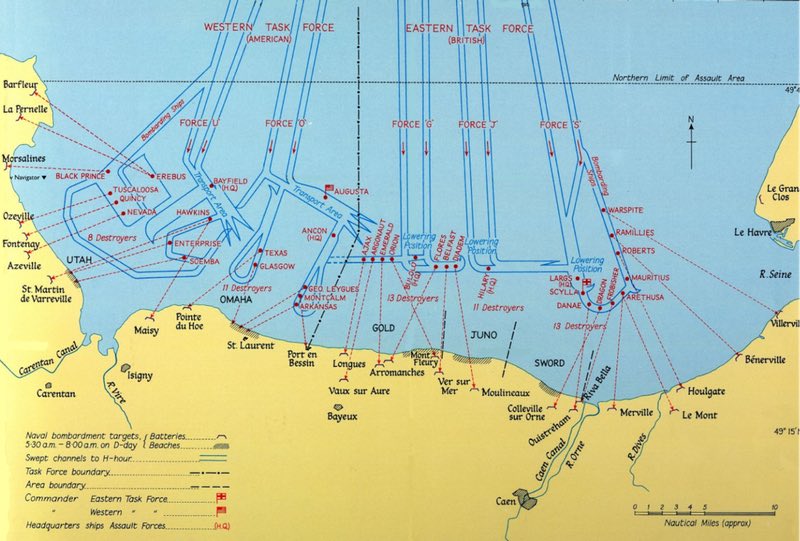




















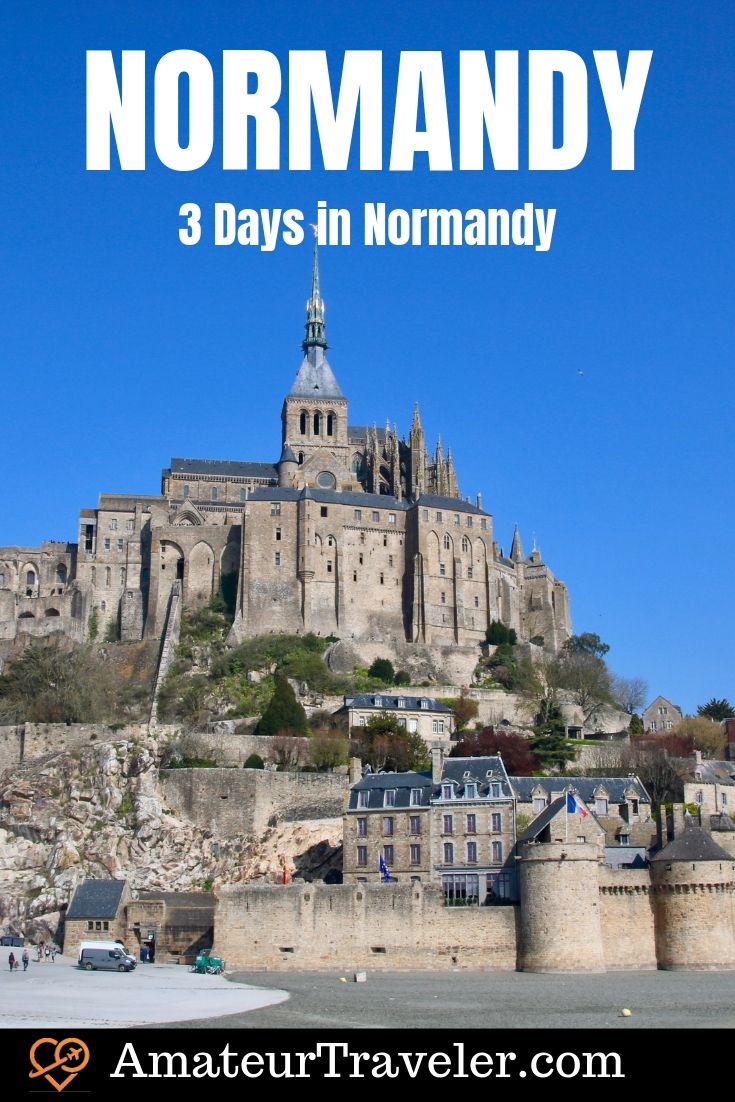
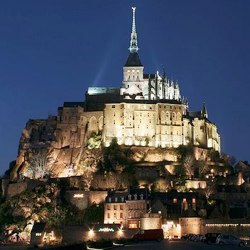 Travel to Normandy in France – Episode 275
Travel to Normandy in France – Episode 275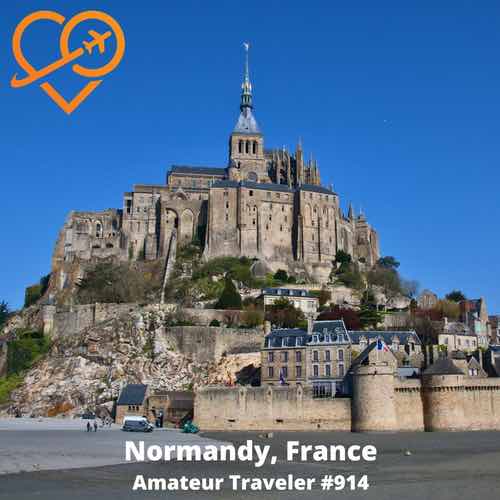 Travel to Normandy, France – Episode 914
Travel to Normandy, France – Episode 914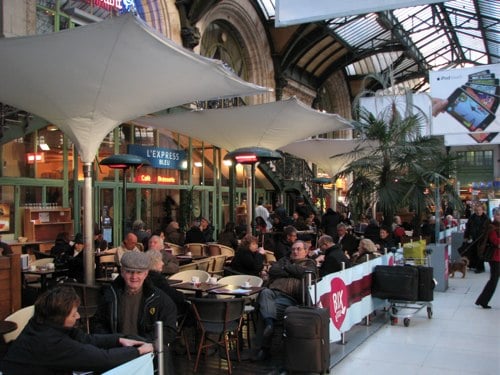 7 Reasons to take the train in France instead of a plane
7 Reasons to take the train in France instead of a plane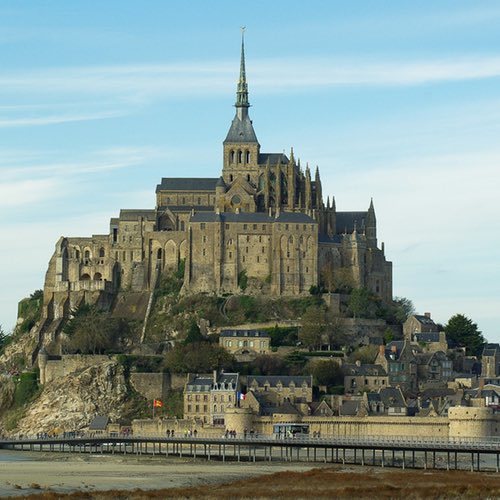 3 Week Road-Trip Around France
3 Week Road-Trip Around France

Chuck
Says:June 22nd, 2019 at 4:19 pm
My roommate in college usee to bring Calvados back for us. It made some days in college much more enjoyable. Great post on the beaches of Normandy. My father landed on Utah Beach on D-Day.
Cameron
Says:June 29th, 2019 at 9:06 am
Thank you for this! We are headed to France in November and will overnight in Bayeux. If you had to choose between Honfleur or Rouen for a day trip, which would you pick?
Chris Christensen
Says:June 29th, 2019 at 10:34 am
Rouen is closer to Paris and Honfleur to the rest of Normandy so it will make a difference where you are coming from. I would have to say I liked Honfleur better but there might be more to see in Rouen as it is larger.
Jai Sharma
Says:July 12th, 2019 at 5:08 am
I am planning for a group of 8 people, 12 days tour to Europe. While browsing, i got your blog and really liked the itinerary for Normandy.
Chris Christensen
Says:July 12th, 2019 at 8:31 am
Glad you like it
Victoria
Says:October 6th, 2019 at 7:45 pm
This is a great article. I am going to Normandy next year for a few days. I am from NZ and had planned to get a train to Caen and rent a car there rather than rent a car in Paris and drive from there, but how difficult is it really to drive from Paris? And given it would be opposite for us? Thanks!
Chris Christensen
Says:October 7th, 2019 at 7:56 am
Once you get out of Paris it was easy. We did run into slow traffic in Paris. Ah, if driving on the other side, I might get a good night’s sleep first.
Victoria
Says:October 9th, 2019 at 6:53 pm
So besides slow traffic, it wasn’t difficult to drive from CDG?
Maureen McCarthy
Says:October 2nd, 2023 at 8:14 pm
Dear Mr. Christensen, I liked your itinerary. I’d like to take my son to visit the beaches in Normandy in the fall of 2024. In researching Normandy, I read about a couple (of Brits) whom I believe now live in or near Normandy. The husband conducts private tours which I’d be interested in. Of course, I’m now unable to retrieve any information about them. If you’re aware of them or any other tour guides you’d recommend, I’d be truly grateful if you’d let me know.
Maureen McCarthy
Chris Christensen
Says:October 3rd, 2023 at 7:35 am
Maureen, we did not have a guide on this trip so I don’t have one I can recommend.
Chris